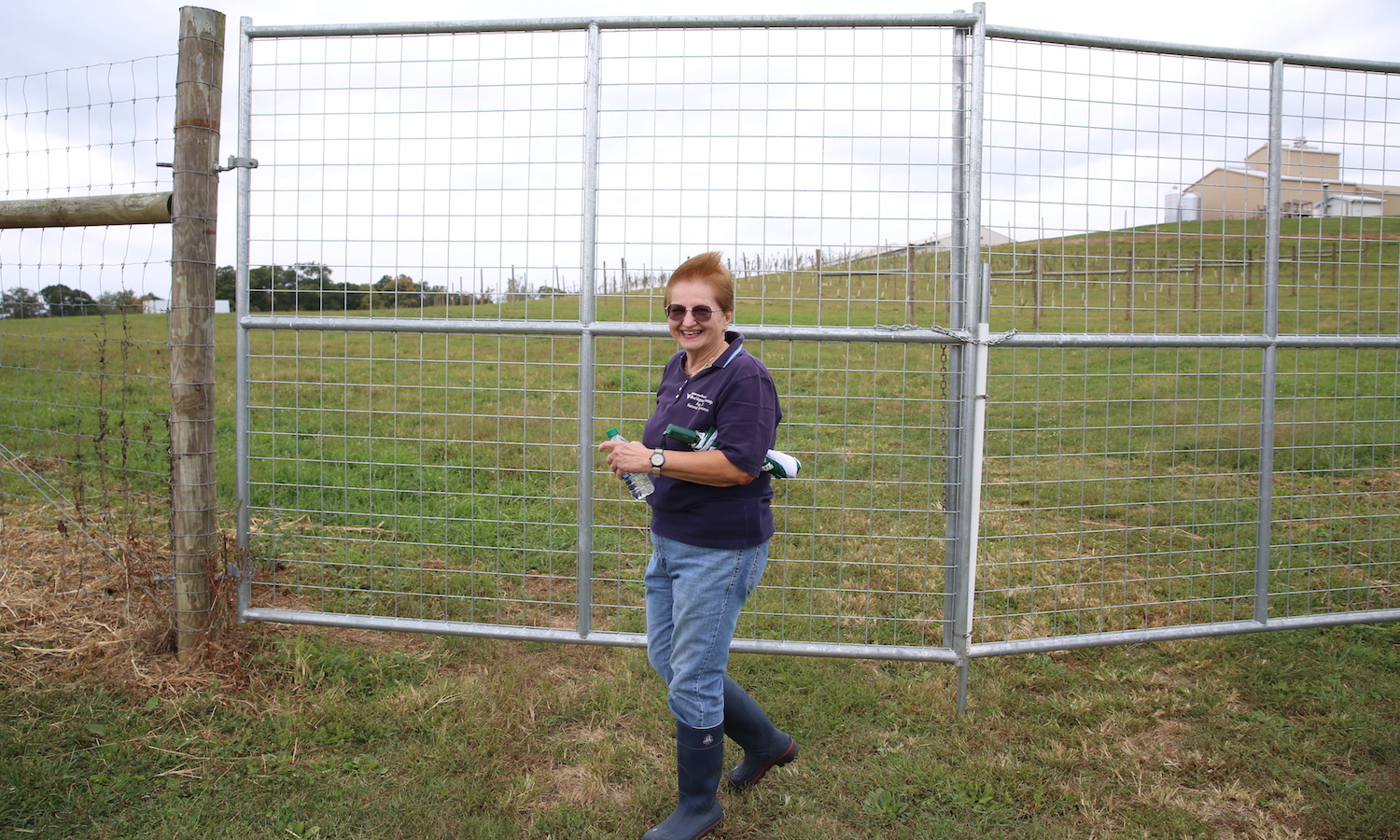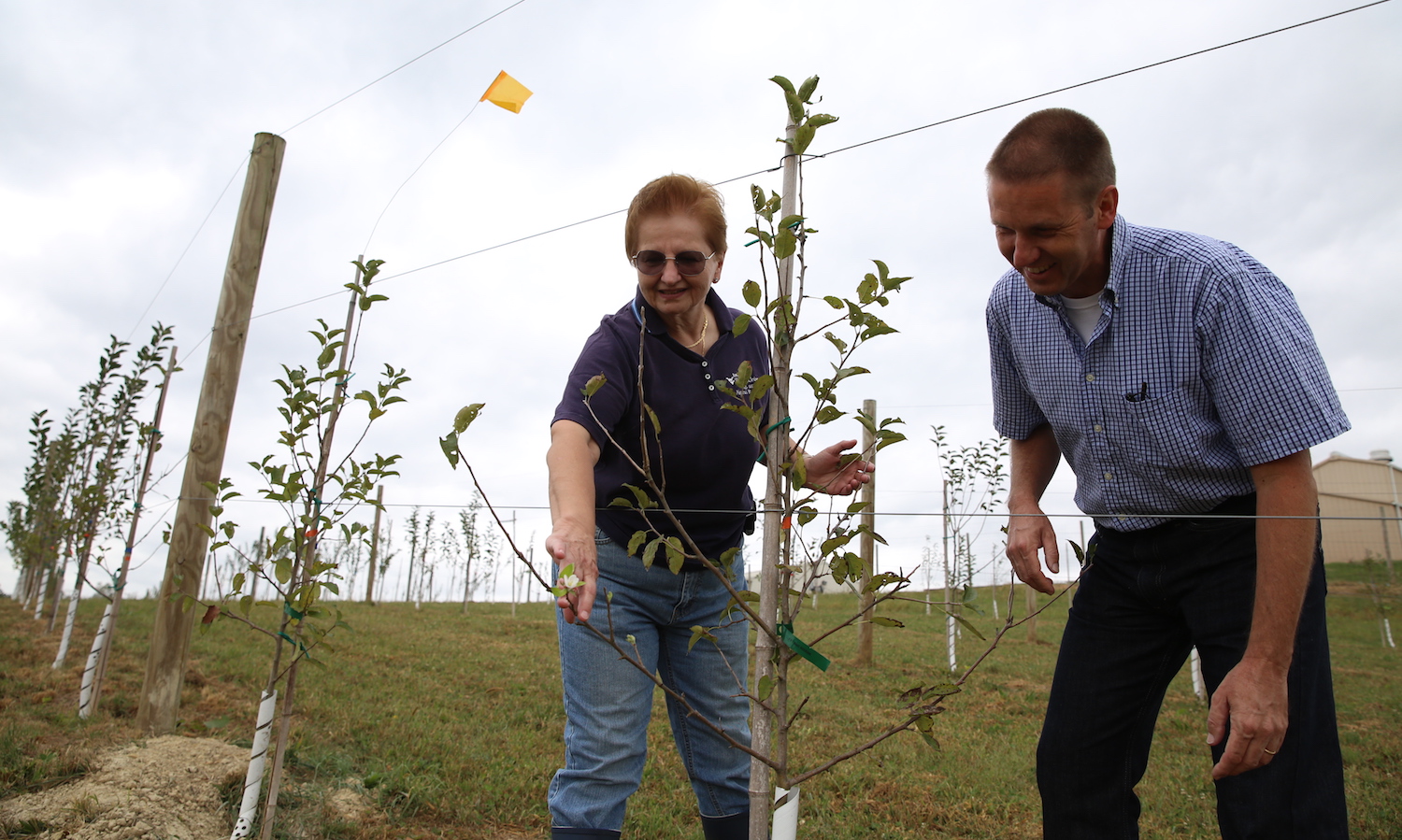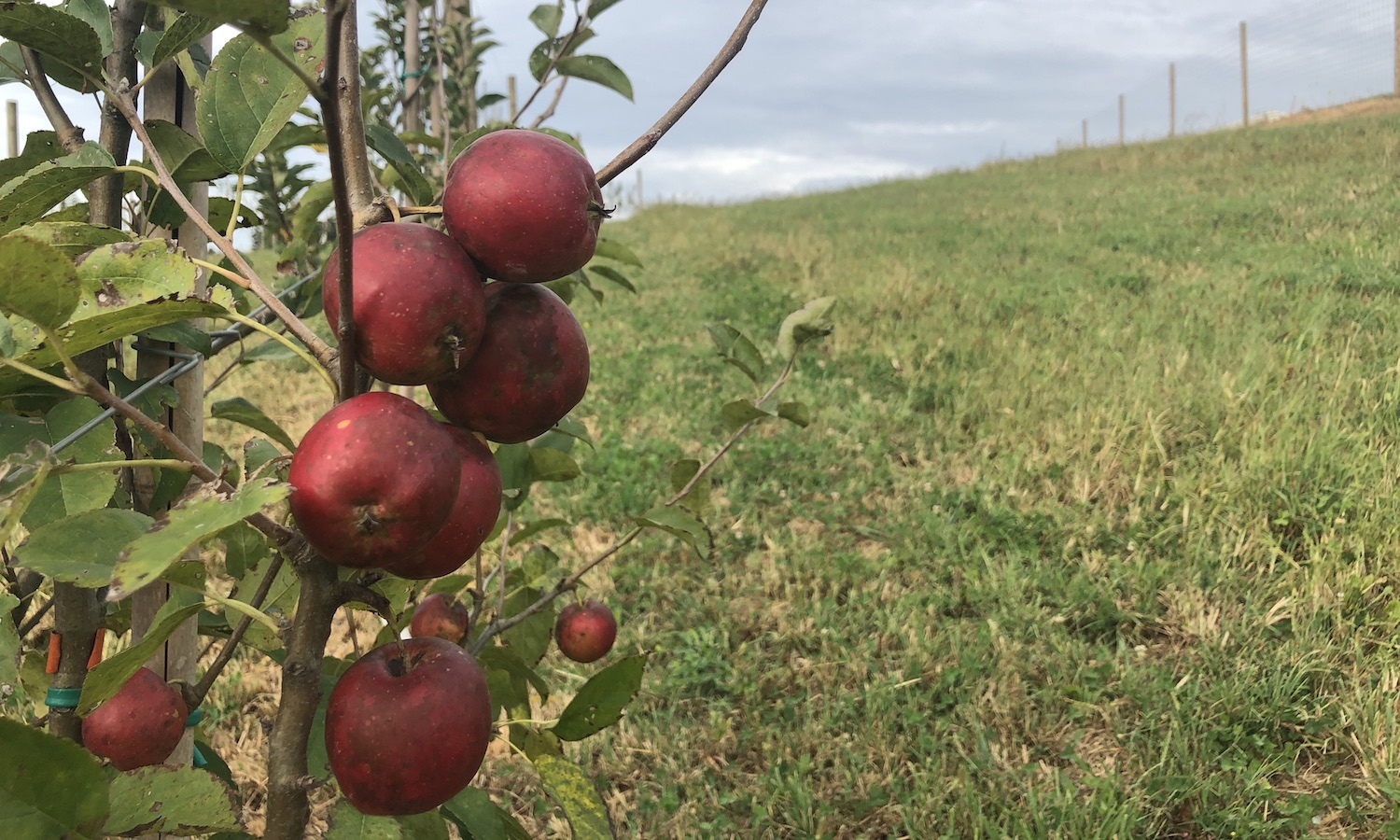A quality cider is the result of a fine-tuned recipe, with each apple variety contributing a certain component to the final product, Michael Gutensohn tells Food Tank. Gutensohn is Assistant Professor of Horticulture at West Virginia University (WVU), where he and Extension Specialist Mirjana Bulatovic-Danilovich manage the Appalachian Apple Initiative seed-orchard, home to 43 cider apple varieties—most of which have been grown in West Virginia since the 1700s. Gutensohn and Bulatovic-Danilovich walk Food Tank and The Crop Trust through the orchard as part of the #CropsInColor in Appalachia tour, explaining why diversity is a must for quality cider and how small farmers are profiting from the growing industry.
Just as grapes aren’t eaten off the vine at a vineyard, these apples aren’t meant to be sampled. “Some of the apples here are called spitters,” or apples that are too bitter for eating fresh but contribute important complexity to a cider blend. “They’re by no means table or sauce apples,” Gutensohn laughs. While some contain more sugar to get alcohol fermentation going, others bring the acidity, tartness, or aroma to a blend.
Gutensohn and Bulatovic-Danilovich are studying which varieties are best suited for growing in West Virginia, specifically the environmental conditions as well as cropping potential, fruit quality, and disease susceptibility. West Virginia is home to many microclimates because of its unique topography, and the team is testing to optimize varieties for each. They have replicated their orchard at a farm in the eastern panhandle of the state and have another in the works, in addition to agreements with several West Virginian growers and cideries that grow the trees to provide samples for research.
Constantly on the lookout for new varieties for the collection, Gutensohn and Bulatovic-Danilovich work with both the U.S. Forest Service and the U.S. Department of Agriculture, who often stumble on old apple trees in forests where settlements used to be. Those trees are geotagged, and Gutensohn and Bulatovic-Danilovich then visit the locations to see if the trees bear unique apple varieties.
“If a tree is surviving on its own in the woods for 100 to 150 years [and] forgotten, that’s exactly what we’re looking for,” Gutensohn says. “We suspect there are way more varieties out there, but in most cases, there’s no written documentation. You have to go out and find it, then preserve it.” And with new genetic tools, they can now identify and document how each apple variety is distinct from one another.
Apple growing is embedded in West Virginia’s history. The widely produced Golden Delicious and Grimes Golden (thought to be the parent of Golden Delicious apples) varieties originated in the state. When hard cider was the drink of choice in America in the 1800s, West Virginian farmers grew and chose heritage varieties for their tartness and juicing qualities. But after Prohibition in the 1920s halted the sale of hard cider, these farmers moved towards growing table apples, chosen for appearance and fresh taste—and diversity suffered.
The quantity of West Virginian apple production has fallen, as well. “It’s a generational switch. Old folks retire from growing on their orchards and the young folks don’t necessarily want to pick it up, because you can’t make money out of growing table and sauce apples,” Gutensohn says. Bulatovic-Danilovich adds that it’s difficult to compete with farmers growing on thousands of acres in Washington, New York, and Michigan. Table apple farmers in West Virginia must work with smaller plots of land and often irregular, hilly terrain.

But now, a growing cider industry is renewing interest in those bitter, irregular cider apple varieties—and West Virginian farmers are benefiting.
Retail cider sales in the United States has grown 10 times in the past decade. There were fewer than 200 cider producers in 2011, and today there are more than 1,000, according to Michelle McGrath, Executive Director of the U.S. Association of Cider Makers in Portland, Oregon. And consumer interest is shifting towards local and independent cider brands, which currently hold 34 percent of the market share.
“Terroir isn’t just for grape wine, and cider has a vast stylistic range. Cider drinkers are starting to mature their palates and are beginning to explore the regionality of U.S. cider,” McGrath tells Food Tank. While most commercial hard ciders in the U.S. are made from standard, sweet apple juice concentrate, often imported from China, regional cideries are tapping into local ingredients.
“It’s much more conducive to a small farmer,” Bulatovic-Danilovich says. Table apples are typically grown to be uniform, blemish-free, and of a certain size and color to meet consumer demand, but “[cider apples] can have blemishes, they can be unevenly shaped, they can be shriveled, it doesn’t matter,” Gutensohn adds.
For apple growers facing a changing climate and unpredictable frost patterns in recent years, this flexibility in crop appearance and variation can be of benefit. “Every farmer I know, and I know many, can cite impacts of changing weather patterns,” says McGrath.
“Cider apples and making cider is a new and clearly developing market, and an alternative crop that growers can switch to,” Gutensohn says, emphasizing that Appalachian growers already have the knowledge and land.
And the team has connected with many people without an agricultural background who are interested in eventually starting an orchard of their own. For unemployed coal miners or other West Virginians struggling in a strong economic divide, cider apple growing could provide options for employment or diversifying income.
“They might not have 100 acres, but they can grow some apples and still make money out of 10 acres. Particularly if they make the cider on top of [growing the apples], because that’s value-adding,” Gutensohn explains. “All of a sudden you’re competitive and you can live on that.”
Bulatovic-Danilovich estimates that with high-density systems, growers could produce 24 to 32 bins per acre, selling at US$300 to US$600 per bin for cider, compared to US$80 to US$120 per bin for table apples.
“Right now, the biggest bottleneck in the cider market is availability of the right apples. So even just growing them makes [you] some money already,” according to Gutensohn. West Virginia has about 7,000 bearing acres of apples but only two registered cideries: Hawk Knob Hard Cider and Mead in Hillsboro, and Swilled Dog Hard Cider in Franklin. West Virginian cider makers will go to Virginia and pay as much as US$400 to US$600 per bin for certain apples to produce their ciders, Bulatovic-Danilovich says.
Now, the team at WVU hopes to do more than collect and preserve heirloom apple varieties for cidermakers—they’re looking at the microbiome of the apple surface in hopes of developing a cider yeast for local producers. Having recently started isolating yeast from apples in the region, they are testing several dozen to see how they perform. “All of these [cidermakers] are small enterprises so they can’t afford to do research on their own,” Gutensohn tells Food Tank. “Farmers have the expertise on the product, WVU does on the research.” He hopes to have a good cider yeast for local cidermakers in the next couple of years.

It’s year three on the seed-orchard and the trees are still relatively small. But while they develop and research moves forward, Gutensohn and Bulatovic-Danilovich continue to form meaningful partnerships to support local cidermakers as well as the culture, cuisine, and biodiversity connected to West Virginian heirloom apples.
“Washington might have significantly more apples, probably as much as the eastern U.S. put together, but they don’t have the climate,” according to Bulatovic-Danilovich. “They can have beautiful looking apples, but when you bite into it, it’s like cardboard. We have the better-quality apple.”
Gutensohn and Bulatovic-Danilovich’s work at WVU is preserving an apple diversity that will play an important role in the growing regional cider industry, allowing producers to create and offer unique blends and single-varietal ciders that showcase what makes Appalachia unique.
The Crop Trust #CropsInColor campaign sheds light on the complexities, triumphs, and surprises of crop diversity in action. In Phase II (2018–2021), #CropsInColor takes a look at 10 crops, exploring how each in its own way has become a staple in our kitchens, markets, and favorite restaurants, no matter where we live. The campaign highlights the important role that crop diversity plays in our daily lives and the need to safeguard this precious, global common good.
The Crop Trust #CropsInColor campaign is sponsored by Corteva with additional funding provided by the Oak Spring Garden Foundation. Food Tank is the media partner.















